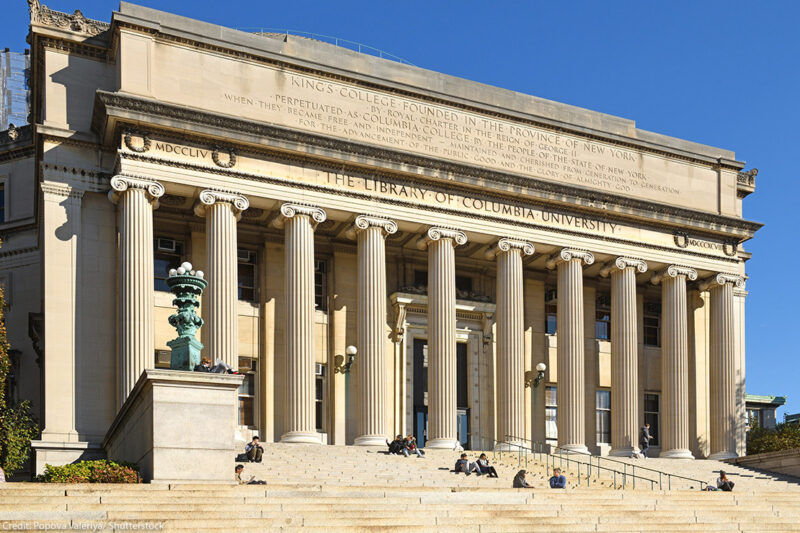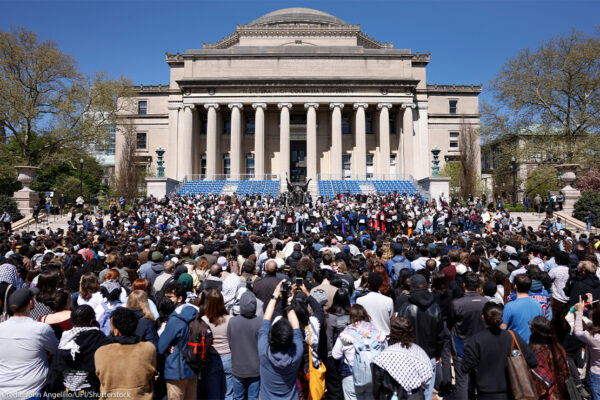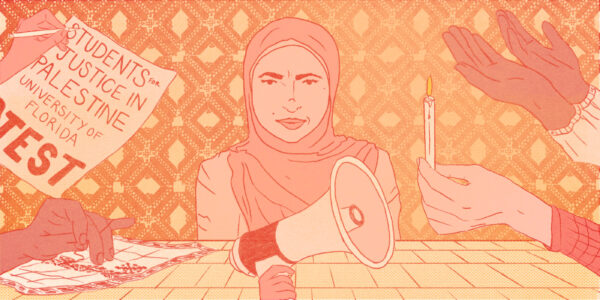I’m a Columbia Student Journalist. I Watched Censorship Unfold on My Own Campus.


Editor’s Note: The şěĐÓĘÓƵ is committed to fighting for all reporters’, including the student press’, right to hold those in power accountable. Through “Press in Peril,” our ongoing series, we’re highlighting the challenges facing the press in a democracy under pressure. For student press resources visit the
Last year, during the Spring semester of my sophomore year at Barnard College, I was leaving class when I received a text from my colleague at the Columbia Daily Spectator, our university newspaper where I work as a deputy opinion editor. She wanted me to come see what was unfolding on the South lawn of Columbia’s Manhattan campus. NYPD officers had lined up, preparing to arrest more than 100 students who had set up an encampment on the lawn as then-Columbia President Minouche Shafik testified before Congress.
For the first time since 1996, Columbia administration had authorized NYPD presence on campus to arrest students. Swaths of students gathered around the lawns as the police entered the side gates to arrest protestors, carrying them off to buses one by one. This would not be anything like the protests we had seen the past school year. That finals season, I spent hours huddled with friends in dorm rooms and libraries. We listened closely to on-the-ground reporters from WKCR, Columbia’s student-run radio, and constantly refreshed the Columbia Daily ł§±č±đł¦łŮ˛ąłŮ´Ç°ů’s website for updates on the protests and arrests happening outside our windows.
With threats to academic freedom and a spotlight on universities across the country, student journalists are essential to providing perspective and balanced coverage of campuses. In some cases, student publications also provide essential reporting to communities beyond campus. Since campuses erupted as students protested Israel's actions in Gaza, student reporters have shared essential information about the protests and kept the campus community updated on important news. For example, Columbia’s student-run radio station, WKCR, livestreamed for nearly 24 hours straight during the two weeks The Gaza Solidarity Encampment rested on our West South Lawn.

Free Speech
Open Letter to College and University Presidents on Student Protests

Free Speech
Open Letter to College and University Presidents on Student Protests
As Columbia University gained immense attention – nationally and internationally – our newspapers’ reporting and op-eds gained newfound attention from reporters, elected officials, and other stakeholders across the country grasping for an idea of what was going on behind Columbia’s closed gates. Columbia Daily Spectator is financially distinct from Columbia University, which ensures that student journalists can report independently. In the opinion section, we worked tirelessly throughout the spring of 2024 to edit and publish op-eds from various stakeholders, including diverse groups on campus, alumni, and even the university administration. The Editorial Board deliberated for hours while writing a series of staff editorials capturing and on campus.
A year later, it was springtime on campus again. The stakes for the student press looked different. President Donald Trump took office in January 2025, and his administration began to launch investigations into Columbia University, soon cutting approximately $400 million in federal funding. With another national spotlight on the university, Columbia began to grapple with federal investigations and negotiations, continued student protests, and international media scrutiny. Columbia’s highest leadership refused to sit down with Spectator journalists throughout Spring 2025. With each protest that happened on campus, the university cracked down harder on media attention, turning away student journalists from protest areas. This made it harder for our student press to do our jobs.
For student journalists, our fears of censorship and retaliation compounded when ICE agents took Tufts University Ph.D. student, RĂĽmeysa Ă–ztĂĽrk in broad daylight and her in Louisiana because she co-wrote an in 2024 with three other students in The Tufts Daily. The op- ed criticized the school for dismissing the student senate's role in student governance and called on the Tufts administration to implement the resolutions it had passed, including disclosing investments and divesting from Israel. Her byline led to her arrest. We saw this as an attack on our rights as student press and on the ability for those who authored pieces on our opinion page to share their voices and viewpoints.
Since October 2023, the fall of my sophomore year, ł§±č±đł¦łŮ˛ąłŮ´Ç°ů’s opinion page had housed at least a dozen articles that addressed the university’s suppression of student speech on the war in Gaza. We had to have conversations about staff editorials and op-eds written during Spring 2024 when both Barnard and Columbia had passed similar student council resolutions calling for divestment. Were writers for ł§±č±đł¦łŮ˛ąłŮ´Ç°ů’s opinion section next to be arrested for writing an op-ed? We feared this new administration would not stop there. Perhaps Trump would come after international students on our editorial board for their participation in writing staff editorials on the president’s policies.
Our fears were realized when the school began to launch investigations into student protestors, using their participation in writing Spectator op-eds to justify the school’s charges. When I heard this was happening, it unlocked a new sense of paranoia for me and other staffers. I wondered if the Editorial Board’s criticism of Trump’s policies would place us under investigation next.
As a U.S. citizen, I had the ability to share my views on current events with less fear than other students I had worked alongside for so long. I had honest conversations in pitch meetings and on production nights with other editors and writers about how to frame an argument or whether to pursue a specific topic in their writing, as well as many conversations with international students who were hesitant to express their views on paper.
Part of this fear stemmed not only from the administration’s crackdown but also the campus environment. At Columbia and Barnard, during the height of the student-led protests, it was not uncommon to pass trucks or scroll through websites bearing the faces of fellow students with their personal information displayed because of the opinions they shared in op-eds or on social media. This reality led to requests of anonymity or off-the-record commentary from students afraid their words could lead to harassment, doxxing, or retaliation.
After a protest in Barnard College’s Milstein Library, two WKCR journalists from Barnard’s Community Accountability, Response, and Emergency Services office. They requested a meeting with the students to provide information refuting that they were involved in the protests. Barnard asked these student journalists to prove they were with the press and provide other information in a closed-door meeting or face punishment via the student code of conduct. The meeting was later cancelled by the school but not before stoking fear amongst student reporters that their reporting could implicate them in the campus disciplinary investigations.

Free Speech
A Comic That Illustrates the Fight to Protect Free Speech on Campus

Free Speech
A Comic That Illustrates the Fight to Protect Free Speech on Campus
Despite some barriers to campus press freedom during the tensest moments of the Spring 2024 protests, Barnard and Columbia did initially separate student reporters from protestors, allowing reporters to enter protests and cover the events without penalty. This is in sharp contrast to some schools, such as and , where student journalists have been arrested for similar reporting on student protests, with some facing felony charges and academic discipline.
This past Spring, however, my school broke from their previous behavior. For the first time, three student journalists were after covering the Library protest. For less than 24 hours, these students were prohibited from taking final exams and told they must vacate their student housing. Rather than studying for finals, these students spent the day in anxious attempts to prove to the school that they were student journalists despite doing all the right things: identifying themselves on the scene, wearing press badges, and reporting in a professional manner.
, student press outside the library were restrained and shoved by school public safety officers and denied access to the main area where protests were unfolding – despite having press badges. If not for the three journalists who faced suspension, crucial reporting from the field would not have existed, including a timeline of events, video footage, and photos inside of the library. Even though these suspensions were temporary, it certainly sent a chilling message throughout Columbia and Barnard’s student press community — reporting on protests could impact their academic status.
After months of trying to meet with the Acting Columbia President Claire Shipman, she finally agreed to an interview with Spectator student journalists in the wake of Columbia’s $200 million settlement with the Trump administration. This is the first time Shipman has sat down with the student press – a significant turning point in the silence from administration toward the student press for the past six months.
Student journalists at Barnard and Columbia are not alone. Universities across the country continue to crack down on student press. I know that a free press is critical to our society. Columbia’s student journalists have worked tirelessly to follow protocol instituted by the university, while also learning how to function as the University’s Fourth Estate, keeping power accountable. As I start the new school year and my senior year, I hope student reporters, editors, and press broadly can continue to hold those in power on campus accountable for their actions and inform communities in the process. I hope to spend my last year on the opinion section working on new projects, continuing to cover unfolding situations on campus, and upholding the opinion section’s motto to “reflect and direct campus discourse.”
This piece has also been updated with the correct year police were last called on campus during a protest.

